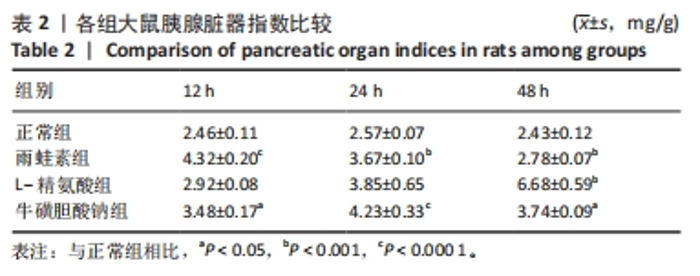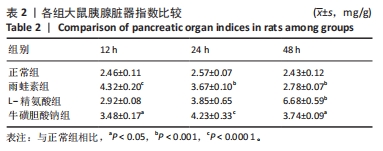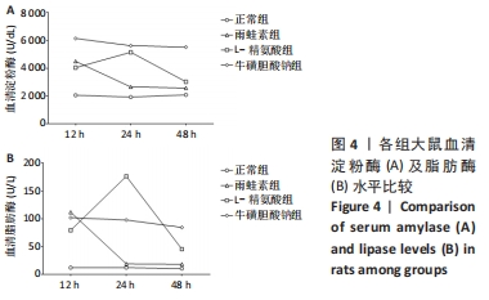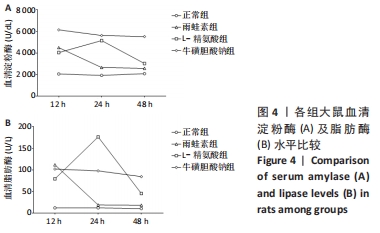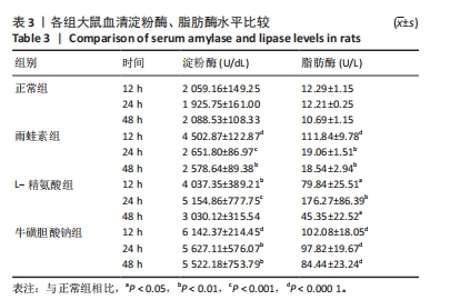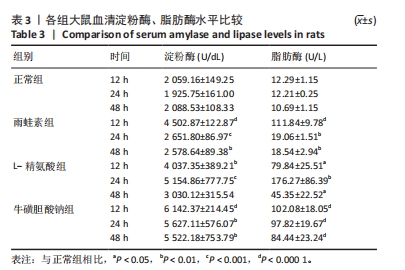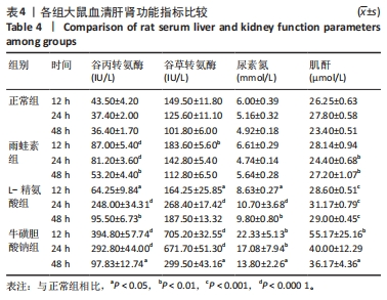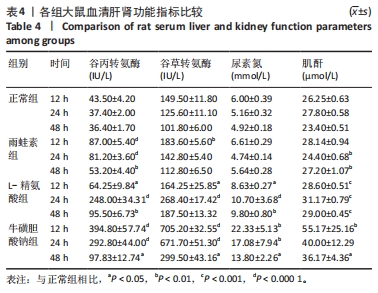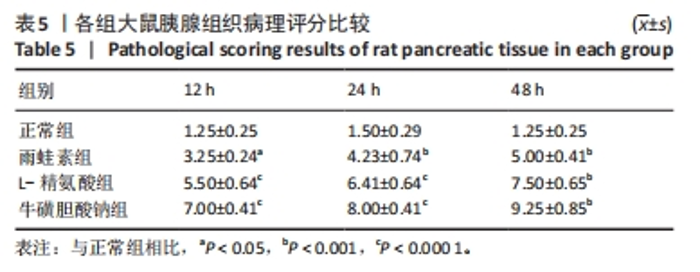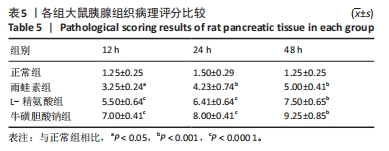Chinese Journal of Tissue Engineering Research ›› 2024, Vol. 28 ›› Issue (34): 5480-5486.doi: 10.12307/2024.835
Previous Articles Next Articles
Preparation and characteristics comparison of three acute pancreatitis rat models
Niu Xiaolong1, Chen Jialiang1, Zheng Huaqun1, Yang Guimei1, Yao Guangtao1, 2
- 1Shanghai Innovation Center of TCM Health Service, 2Center for Drug Safety Evaluation and Research, Shanghai University of Traditional Chinese Medicine, Shanghai 201203, China
-
Received:2023-11-28Accepted:2024-01-20Online:2024-12-08Published:2024-03-14 -
Contact:Yao Guangtao, MD, Researcher, Master’s supervisor, Shanghai Innovation Center of TCM Health Service, Shanghai University of Traditional Chinese Medicine, Shanghai 201203, China; Center for Drug Safety Evaluation and Research, Shanghai University of Traditional Chinese Medicine, Shanghai 201203, China -
About author:Niu Xiaolong, Master candidate, Shanghai Innovation Center of TCM Health Service, Shanghai University of Traditional Chinese Medicine, Shanghai 201203, China -
Supported by:Biomedical Science and Technology Support Program of Shanghai Municipal Science and Technology Commission, No. 22S21901300 (to YGT)
CLC Number:
Cite this article
Niu Xiaolong, Chen Jialiang, Zheng Huaqun, Yang Guimei, Yao Guangtao. Preparation and characteristics comparison of three acute pancreatitis rat models[J]. Chinese Journal of Tissue Engineering Research, 2024, 28(34): 5480-5486.
share this article
Add to citation manager EndNote|Reference Manager|ProCite|BibTeX|RefWorks
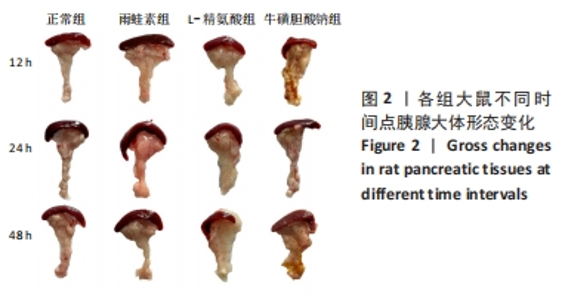
2.1 大鼠的死亡率/存活率 正常组、雨蛙素组各个时间点无死亡,存活率100%;L-精氨酸组12 h死亡1只,24 h死亡2只,48 h无死亡,总存活率88%;牛磺胆酸钠组12 h死亡1只,24 h和48 h无死亡,总存活率96%。 2.2 胰腺大体形态观察 造模后12,24,48 h后取材,正常组胰腺组织呈灰红色,胰周无明显改变,解剖时腹腔内未见腹水;雨蛙素组12 h大体观察可见胰尾部轻度水肿、分叶模糊、疏松,24 h胰头胰尾间质水肿明显,48 h胰头部水肿有所缓解;L-精氨酸组12 h可见胰腺水肿明显,24 h胰腺腺体增大增厚并伴有点片状出血,48 h胰腺腺体变薄,伴血性腹水;牛磺胆酸钠组12 h胃肠道积液、积气及血性腹水,胰周充满黄色斑块脂肪组织坏死及皂化斑,24 h胰腺组织出现不同程度充血水肿伴散在点片状出血坏死,48 h胰腺结构完全破坏。见图2。"
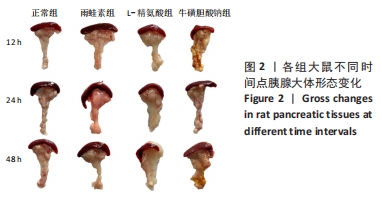
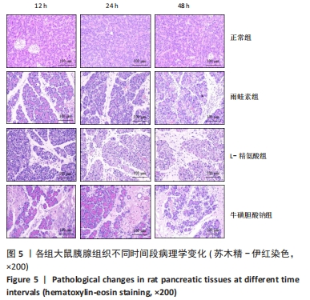
2.6 胰腺组织病理学变化 光镜下观察可见,正常组各时间点胰腺腺泡正常,胰岛结构完整,无出血点,未见小叶间隙增宽,偶见炎性细胞。雨蛙素组12 h胰腺腺泡轻度水肿,小叶间隙增宽,炎性细胞增多;24 h小叶结构紊乱及小叶间间隙增宽,可见点片状坏死灶,炎性细胞浸润;48 h胰腺腺泡水肿,弥漫性炎性细胞浸润及片状坏死。L-精氨酸组12 h腺泡结构破坏,小叶间轻度水肿,坏死灶散在分布及少量炎性细胞浸润;24 h小叶间隙增宽,大量炎性细胞浸润,片状坏死点;48 h胰腺腺泡完整度,大片区域坏死及炎性细胞浸润。牛磺胆酸钠组12 h小叶间隙增宽,坏死灶散在分布,大量炎性细胞浸润;24 h组胰腺片状坏死及少量出血点,大量炎性细胞浸润;48 h组腺泡水肿明显结构紊乱,大量坏死灶及炎性细胞浸润。见图5。"
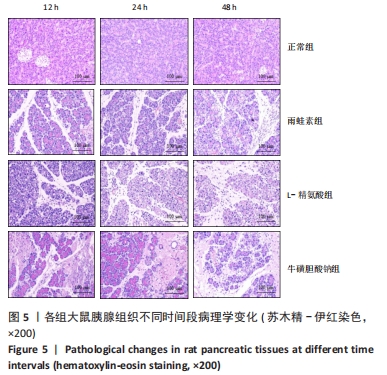
| [1] SONG Y, ZHANG Z, YU Z, et al. Wip1 Aggravates the Cerulein-Induced Cell Autophagy and Inflammatory Injury by Targeting STING/TBK1/IRF3 in Acute Pancreatitis. Inflammation. 2021;44(3):1175-1183. [2] DING SP, LI JC, JIN C. A mouse model of severe acute pancreatitis induced with caerulein and lipopolysaccharide. World J Gastroenterol. 2003;9(3): 584-589. [3] 杜奕奇, 陈其奎, 李宏宇, 等. 中国急性胰腺炎诊治指南(2019年,沈阳)[J]. 临床肝胆病杂志,2019,35(12):2706-2711. [4] XIAO AY, TAN ML, WU LM, et al. Global incidence and mortality of pancreatic diseases: a systematic review, meta-analysis, and meta-regression of population-based cohort studies. Lancet Gastroenterol. 2016;1(1):45-55. [5] BOXHOORN L, VOERMANS RP, BOUWENSE SA, et al. Acute pancreatitis. Lancet. 2020;396(10252):726-734. [6] HE L, WANG L, HOU H. Bicarbonated Ringer’s solution improves L-arg-induced acute pancreatitis in rats via the NF-κB and Nrf2 pathways. Scand J Gastroenterol. 2023;58(3):276-285. [7] ZHANG L, SHI J, DU D, et al. Ketogenesis acts as an endogenous protective programme to restrain inflammatory macrophage activation during acute pancreatitis. EBioMedicine. 2022;78:103959. [8] LIU X, LUO W, CHEN J, et al. USP25 Deficiency Exacerbates Acute Pancreatitis via Up-Regulating TBK1-NF-κB Signaling in Macrophages. Cell Mol Gastroenterol Hepatol. 2022;14(5):1103-1122. [9] 李涛,王海燕,刘丽玲,等. 大鼠实验性急性胰腺炎动物模型的建立[J]. 中国比较医学杂志,2003,13(6):358-361. [10] LIN R, LI M, LUO M, et al. Correction to: Mesenchymal stem cells decrease blood-brain barrier permeability in rats with severe acute pancreatitis. Cell Mol Biol Lett. 2019;24:56. [11] LEE PJ, PAPACHRISTOU GI. New insights into acute pancreatitis. Nat Rev Gastroenterol Hepatol. 2019;16(8):479-496. [12] NEPOMNYASHCHIKH LM, LUSHNIKOVA EL, VISKUNOV VG, et al. Ultrastructure of acinar cell injuries in experimental acute pancreatitis created by common bile duct ligation. Bull Exp Biol Med. 2011;150(6):747-752. [13] JAWOREK J, SZKLARCZYK J, KOT M, et al. Chemerin alleviates acute pancreatitis in the rat thorough modulation of NF-κB signal. Pancreatology. 2019;19(3):401-408. [14] ABDELZAHER WY, AHMED SM, WELSON NN, et al. Vinpocetine ameliorates L-arginine induced acute pancreatitis via Sirt1/Nrf2/TNF pathway and inhibition of oxidative stress, inflammation, and apoptosis. Biomed Pharmacother. 2021;133:110976. [15] 杨丹, 孙银凤, 白敏, 等. 基于PI3K/AKT信号通路的大黄牡丹汤对急性胰腺炎大鼠肺组织细胞凋亡及炎症反应的影响[J]. 中国中医药信息杂志,2022,29(7):73-79. [16] EL-ASHMAWY NE, KHEDR NF, EL-BAHRAWY HA, et al. Suppression of inducible nitric oxide synthase and tumor necrosis factor-alpha level by lycopene is comparable to methylprednisolone in acute pancreatitis. Dig Liver Dis. 2018;50(6):601-607. [17] KUSSKE AM, RONGIONE AJ, ASHLEY SW, et al. Interleukin-10 prevents death in lethal necrotizing pancreatitis in mice. Surgery. 1996;120(2):284-288,289. [18] EL ME, AHMED M. Carvedilol attenuates l-arginine induced acute pancreatitis in rats through modulation of oxidative stress and inflammatory mediators. Chem Biol Interact. 2020;327:109181. [19] SENDLER M, VAN DEN BRANDT C, GLAUBITZ J, et al. NLRP3 Inflammasome Regulates Development of Systemic Inflammatory Response and Compensatory Anti-Inflammatory Response Syndromes in Mice With Acute Pancreatitis. Gastroenterology. 2020;158(1):253-269. [20] LI XY, HE C, ZHU Y, et al. Role of gut microbiota on intestinal barrier function in acute pancreatitis. World J Gastroenterol. 2020;26(18):2187-2193. [21] NOHOMOVICH B, SHAH A, HUGHES N. Severe, Complicated Pancreatitis With an Unclear Etiology. Cureus. 2023;15(5):e39011. [22] THIEL FG, ASGARBEIK S, GLAUBITZ J, et al. IRAK3-mediated suppression of pro-inflammatory MyD88/IRAK signaling affects disease severity in acute pancreatitis. Sci Rep. 2023;13(1):10833. [23] TOÇOĞLU AG, KÖKSAL AŞ, TOKA B, et al. Validation of the Revised Atlanta Criteria in determining the severity of acute pancreatitis. Eur J Gastroenterol Hepato. 2023;35(10):1137-1142. [24] LAMPEL M, KERN HF. Acute interstitial pancreatitis in the rat induced by excessive doses of a pancreatic secretagogue. Virchows Arch A Pathol Anat Histol. 1977;373(2):97-117. [25] 凤振宁,金世柱.急性胰腺炎动物模型构建方法的研究[J]. 胃肠病学和肝病学杂志,2020,29(4):388-391. [26] GÜL M, EŞREFOĞLU M, OZTÜRK F, et al. The beneficial effects of pentoxifylline on caerulein-induced acute pancreatitis in rats. Dig Dis Sci. 2009;54(3):555-563. [27] LIU LW, XIE Y, LI GQ, et al. Gut microbiota-derived nicotinamide mononucleotide alleviates acute pancreatitis by activating pancreatic SIRT3 signalling. Br J Pharmacol. 2023;180(5):647-666. [28] YOTSUMOTO F, MANABE T, OHSHIO G. Bradykinin involvement in the aggravation of acute pancreatitis in rabbits. Digestion. 1993;54(4):224-230. [29] KLAR E, SCHRATT W, FOITZIK T, et al. Impact of microcirculatory flow pattern changes on the development of acute edematous and necrotizing pancreatitis in rabbit pancreas. Dig Dis Sci. 1994;9(12):2639-2644. [30] SONG R, YU D, PARK J. Changes in gene expression of tumor necrosis factor alpha and interleukin 6 in a canine model of caerulein-induced pancreatitis. Can J Vet Res. 2016;80(3):236-241. [31] BACHMANN K, FREITAG M, LOHALM H, et al. Effects of hydroxyethyl starch and cell-free hemoglobin on microcirculation, tissue oxygenation, and survival in severe acute porcine pancreatitis: results of a randomized experimental trial. Pancreas. 2014;43(6):855-862. [32] DABROWSKI A, KONTUREK SJ, KONTUREK JW, et al. Role of oxidative stress in the pathogenesis of caerulein-induced acute pancreatitis. Eur J Pharmacol. 1999;377(1):1-11. [33] 杨平, 寇明文, 赵戈, 等. L-精氨酸和雨蛙素诱导急性胰腺炎模型的对比研究[J]. 现代生物医学进展,2012,12(15):2810-2813. [34] MIZUNUMA T, KAWAMURA S, KISHINO Y. Effects of injecting excess arginine on rat pancreas. J Nutr. 1984;114(3):467-471. [35] TANI S, ITOH H, OKABAYASHI Y, et al. New model of acute necrotizing pancreatitis induced by excessive doses of arginine in rats. Dig Dis Sci. 1990; 35(3):367-374. [36] ABDELMAGEED ME, NADER MA, ZAGHLOUL MS. Targeting HMGB1/TLR4/NF-κB signaling pathway by protocatechuic acid protects against l-arginine induced acute pancreatitis and multiple organs injury in rats. Eur J Pharmacol. 2021;906:174279. [37] CZAKÓ L, TAKÁCS T, VARGA IS, et al. The pathogenesis of L-arginine-induced acute necrotizing pancreatitis: inflammatory mediators and endogenous cholecystokinin. J Physiol Paris. 2000;94(1):43-50. [38] 尚宏清,李非,张再兴,等. 分次大剂量L-精氨酸腹腔内注射致大鼠急性坏死性胰腺炎模型的研究[J]. 首都医科大学学报,2000(4):322-324. [39] LERCH MM, GORELICK FS. Models of acute and chronic pancreatitis. Gastroenterology. 2013;144(6):1180-1193. [40] 沈佳庆, 杨丽娟, 胡国勇, 等. 牛磺胆酸钠在大鼠急性胰腺炎模型中的半数致死量(LD50)研究[J]. 现代生物医学进展,2011,11(19):3618-3620. [41] 李婷, 仁德芳, 付裕, 等. 柴黄清胰活血颗粒对重症急性胰腺炎模型大鼠的治疗作用研究[J]. 中药药理与临床,2018,34(6):169-172. |
| [1] | Li Rui, Zhang Guihong, Wang Tao, Fan Ping. Effect of ginseng polysaccharide on the expression of prostaglandin E2/6-keto-prostaglandin 1alpha in traumatic osteoarthritis model rats [J]. Chinese Journal of Tissue Engineering Research, 2024, 28(8): 1235-1240. |
| [2] | Hu Zhixing, Li Qun, Yang Chao, Wang Xiaoxiao, Fang Luochangting, Hou Wuqiong, Lin Na, Chen Weiheng, Liu Chunfang, Lin Ya. Network meta-analysis of the modeling effects of different factors on rabbit models of steroid-induced osteonecrosis of femoral head [J]. Chinese Journal of Tissue Engineering Research, 2024, 28(6): 976-984. |
| [3] | Zhou Shibo, Guan Jianbin, Yu Xing, Zhao He, Yang Yongdong, Liu Tao. Animal models of femoral bone defects: preparation status and characteristics [J]. Chinese Journal of Tissue Engineering Research, 2024, 28(4): 633-638. |
| [4] | Gao Simiao, Wu Xiaoguang, Han Xue, Xu Shiqi, Li Kuihua, Peng Yong. Establishment of a rat model of traumatic brain injury using the modified Feeney’s free-fall method [J]. Chinese Journal of Tissue Engineering Research, 2024, 28(26): 4164-4169. |
| [5] | Yang Zongrui, Ge Haiya, Shi Jinyu, Wang Zhengming, Wang Yuanyuan, Li Zhengyan, Du Guoqing, Zhan Hongsheng. Characteristic changes in morphology and function of skeletal muscles in a rat model of “tendon off-position” [J]. Chinese Journal of Tissue Engineering Research, 2024, 28(26): 4170-4177. |
| [6] | Lyu Lijun, Peng Wei, Li Chuangbing, Ye Shuo, Gao Qiuming. Establishment of a rat femoral nonunion model by intramedullary fixation [J]. Chinese Journal of Tissue Engineering Research, 2024, 28(26): 4189-4153. |
| [7] | Huang Jiacheng, Shao Xinxin, Li Haomiao, Du Shaohua, Dai Shuangwu. Construction of an animal model for treating early postoperative infected bacterial biofilms by irrigating after internal fixation [J]. Chinese Journal of Tissue Engineering Research, 2024, 28(23): 3704-3708. |
| [8] | Xiong Bohan, Yu Yang, Zheng Liling, Yang Tengyun, Lu Xiaojun, Wang Xu, Li Kaiwei, Yu Hong, Li Yajuan, Dong Kaiyan, Zhang Yaozhang, Liu Jinrui, Gu Ziming, Hu Bigeng, Li Yanlin. Constructing a model of anterior cruciate ligament reconstruction with autologous Achilles tendon in southern Yunnan small-ear pigs [J]. Chinese Journal of Tissue Engineering Research, 2024, 28(20): 3157-3163. |
| [9] | Ran Lei, Han Haihui, Xu Bo, Wang Jianye, Shen Jun, Xiao Lianbo, Shi Qi. Molecular docking analysis of the anti-inflammatory mechanism of Cibotium barometz and Epimedium for rheumatoid arthritis: animal experiment validation [J]. Chinese Journal of Tissue Engineering Research, 2024, 28(2): 208-215. |
| [10] | Chen Simin, Hu Yingjun, Yan Wenrui, Ji Le, Shao Mengli, Sun Ze, Zheng Hongxing, Qi Shanshan. Establishment and evaluation of a streptozotocin-induced diabetic encephalopathy rat model [J]. Chinese Journal of Tissue Engineering Research, 2024, 28(2): 237-241. |
| [11] | Wu Xiaodan, Wang Zhiguo, Zhan Ying, Zhang Guoxu. Establishment of an acute radioactive skin injury model induced by 32P-beta ray radiation and the mechanism of injury [J]. Chinese Journal of Tissue Engineering Research, 2024, 28(14): 2173-2179. |
| [12] | Xiong Bohan, Lu Xiaojun, Xue Wenqiang, Liu Jinrui, Gao Xianling, Yu Hong, Li Yajuan, Liu Haolong, Li Yanlin. Protective effect of anterior cruciate ligament reconstruction assisted by internal tension-reduction technique on the articular cartilage of southern Yunnan small-ear pigs [J]. Chinese Journal of Tissue Engineering Research, 2024, 28(14): 2221-2226. |
| [13] | Wang Li, Wang Bo. Mechanical analysis and finite element modeling of rabbit patellar tendon and tendon insertion under different mechanical conditions [J]. Chinese Journal of Tissue Engineering Research, 2024, 28(12): 1829-1836. |
| [14] | Zhou Ziying, Ou Shangkun, Huang Chao, Jiang Hao, Zhang Liying, Gu Hao. Changes of the meibomian gland in a mouse model of aqueous deficient dry eye [J]. Chinese Journal of Tissue Engineering Research, 2024, 28(11): 1666-1671. |
| [15] | Han Zhongxiao, Ou Yaying, Zhuang Xinqing, Zhang Xiang, Li Biaoping, Jiang Zhirui, Zhang Jingyi, Yang Jiashun, Tang Ling, Xiao Wei. Mechanical puncture combined with tumor necrosis factor alpha and complete Freund’s adjuvant to construct a rat discogenic low back pain model [J]. Chinese Journal of Tissue Engineering Research, 2024, 28(11): 1672-1677. |
| Viewed | ||||||
|
Full text |
|
|||||
|
Abstract |
|
|||||


